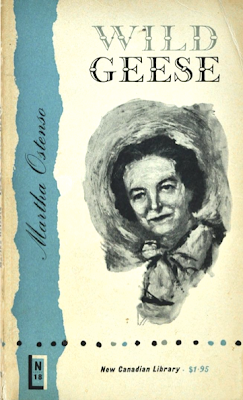Answers as to why so many were so flawed are found in
New Canadian Library: The Ross-McClelland Years, 1952-1978, Janet Friskney's invaluable study of NCL's best days. The author tells us that founder Malcolm Ross was adamant that there be introductions, quoting: "I thought it would be useful even for teachers, many of whom were teaching Canadian books for the first time and who had never studied Canadian literature."
As Prof Friskney notes: "in many cases, an NCL introduction was one of the earliest, and sometimes the first piece of critical analysis to appear about a particular work."

Such a sad state of affairs. The blind led the blind... and yet things did improve. In 1962, Hugh MacLennan wrote Ross that the NCL was on its way to becoming "one of the most important things in Canadian publishing." He went on to praise the series for making available the previously unavailable and scarce, adding: "These, with the introductions, are building a true body of relationship between critic and author and the public."

(MacLennan's
Barometer Rising had already found a place in the series, and would soon be joined by
Each Man's Son.)
All this brings me to Carlyle King's Introduction to
Wild Geese, Martha Ostenso's big book, which I reread just yesterday. The intro first appeared when
Wild Geese joined the NCL in 1961, and was reprinted until 1996, when it was replaced with an afterword by David Arnason.
Thirty-five years.
I first read these words from Prof King in 1986:
Where to begin? How about with that third sentence, in which King describes the literary landscape of 1923 Canada:
Callaghan was on the Left Bank in Paris among the American expatriates, trying his hand at stories for the little magazines of experimental writing...
No, Morley Callaghan was then studying law at the University of Toronto. It was in 1929 that Callaghan first visited the Left Bank, by which time he was a published author comfortably installed within Charles Scribner's stable.
...Grove, who had written for twenty years in the intervals of an itinerant farm-hand's existence, did not get a first novel into print until 1925.
It was in 1905 that Frederick Philip Grove – or, as King seems to prefer, "Philip Grove" – published his first novel. The "itinerant farm hand's existence" included a stretch in Austrian prison, bohemian living in Berlin and Paris, drinks with Andre Gide and H.G. Wells... and I won't go into his crossdressing wife with the birdcage bustle.
The truth about fraudster and faux-Swede Grove – German Felix Paul Greve – was revealed in 1971 through the sleuthing of D.O. Spettigue. While King cannot be faulted for his 1961 Introduction, one wonders that it continued to be used as the new millennium approached.
Carlyle King informs that Grove, Callaghan and Ostenso stand outside "the Sunshine School of Canadian fiction", in which "human nature is fundamentally noble and Rotarian morality always triumphs. The main characters are basically nice people. Nobody ever suffers long or gets really hurt or says "damn.'"
Oh, dear.
In 1923, the most recent of "Louisa [
sic] M. Montgomery's long series of 'Anne' books" was
Rilla of Ingleside (1921). A novel set during the Great War, it sees one of our dear Anne's sons taken prisoner by the Hun as another is slaughtered on the battlefield. It's true that the latter is "killed instantly by a bullet during a charge at Courcelette", but I'm not at all convinced this is what King meant in writing that nobody ever suffers long.
Can we at least agree that in this case a character "really gets hurt"?
A good many characters are killed in Ralph Connor's
The Sky Pilot in No Man's Land – some suffering long before they die.
And "damn"?
There's a whole lotta cussin' goin' on in the novel, much of which comes from the sky pilot himself:
Yes, there's venereal disease, too.
Is it any wonder that no reference to "the Sunshine School of Canadian fiction" is found outside Carlyle King's writings?
Related post:















































